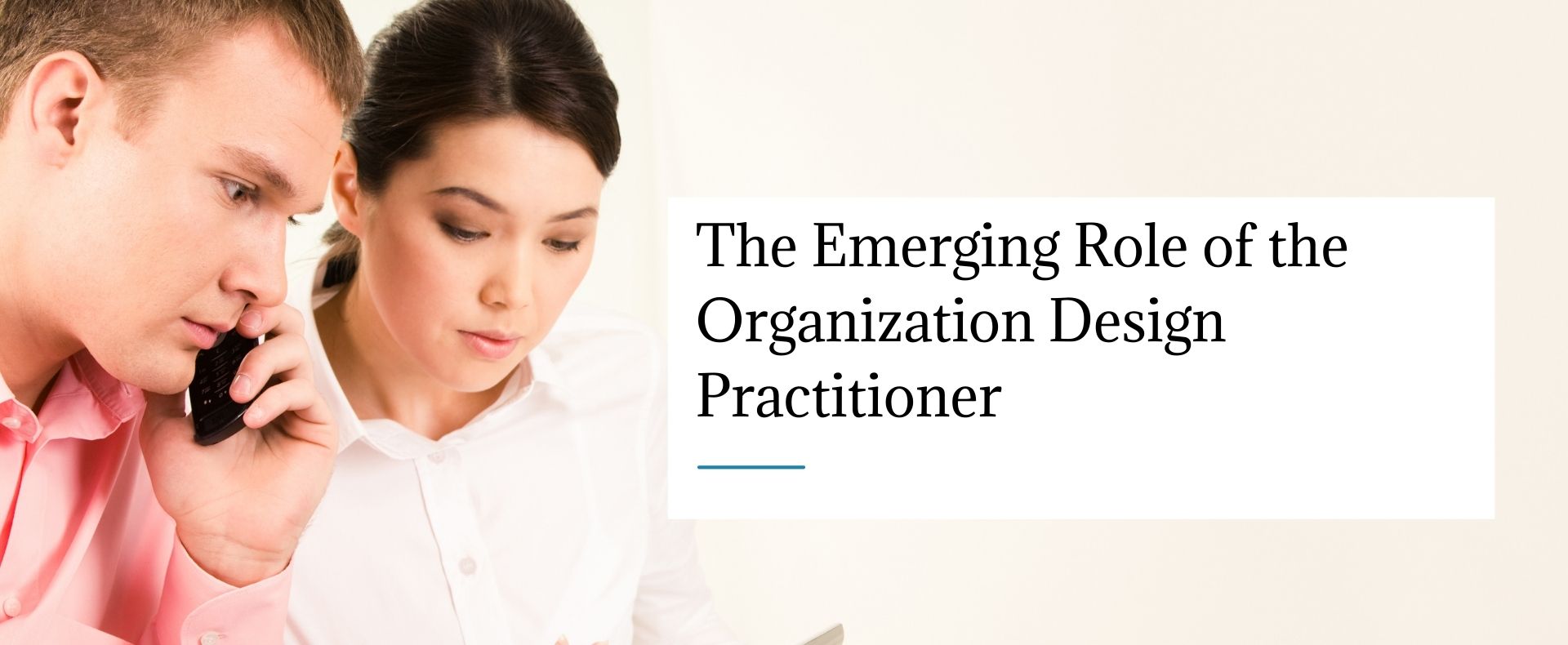Reading Time: 15 minutes
We are witnessing a paradigm shift in the field of organization design. Consequently, the same is happening to the role of organization design practitioner.
As more digital technology is implemented in the organization’s design, the rules used to rely on for value creation and performance are quickly evolving, resulting in a fundamental shift in how enterprises create and deliver value. From legacy top-down, pipeline – driven-out, to digital bottom-up, customer driven-in. In the digital world there is less emphasis on hierarchy and structure where leaders align people and strategic priorities. More emphasis is required on team-based networks driven by customer needs and environmental dynamics. The trend is moving in the direction of micro-structures, product-driven and market segment selforganizing work systems with a focus on technology–people augmentation and innovation. These shifts are impacting the role of organization designers.
Today’s current role
Today’s role of the organization design professional has evolved from the original organization development practitioners1 (OD Network) who specialized in organization design starting in the early 1970s. The approach was likely a strategy-structure alignment top-down methodology of design, utilizing either the STAR model (Galbraith) or congruence model (Nadler and Tushman) as the basic design methodology. Today, this approach is being trained through numerous academic and consulting channels as certified organization design programs.
The independent organization development practitioner was brought into a company typically by line management. In the mid - 80s the Personnel Department changed its name to Human Resources and under the influence of David Ulrich, who invented the HR Business Partners role, became the de facto OD practitioner. HR formalized the organization design role as part of the HR staff. Independent consultants as well as large consulting firms continued to play a role in more complex organization design and change efforts.
Today, internal organizational design consultants are specialist HR professionals who
define and organize the structure of companies, create job titles, and allocate resources to projects and initiatives that support and contribute to the achievement of company people and capability strategies. Independent consultants are also brought into companies to utilize the strategy-structure alignment design process.
New Emerging Role
Today’s emerging role of the organization design professional originated from an open systems socio-technical design (STD), bottom-up approach, that focused on the alignment of technology in doing the work and the social system to perform the work. The STD practitioner usually had a multi-functional background, ranging from human factors, organization psychology, system science, to OD.
As business environments increasingly became more turbulent, competitive strategies turned to innovation, speed, and adaptation as critical capabilities for an organization’s design. Design thinking methodologies, agile software development, and other innovative work design approaches became increasingly central to a company’s strategy. Digital technology has accelerated the need for innovation, speed, and adaptation, and has decentralized decision making. The emerging practitioner, engaged with the executive team, designs for technology–people integration, cross-functional self-organizing work systems, customer/ecosystem integration, and enterprise ambidextrous organization design with executive teams.
Today’s emerging role of the organization design practitioner utilizes an open system bottomup approach that draws from the designer’s toolkit to integrate the needs of people, customer and ecosystems, the possibilities of technology, and requirements for business success.
A forecasted set of skills for the digital organization design practitioner is shown in table 1
below.
Table 1
| # | SKILL | DESCRIPTION |
| 1 | Basic consulting skills |
Basic consulting skills: contracting, entry, including data gathering, assessment, diagnosis, feedback, planning, intervention, evaluation, follow-up. |
| 2 | Digital Socio-technical design | Methodology to include business model, digital, technical, and social systems analysis, customer journey mapping and ecosystems design, work systems design, prototyping, and scaling. |
| 3 | Portfolio of design competencies |
Business model design, experience design, product and service design, technology-human augmentation, strategy-structure alignment design, Transformational design. |
| 4 | Adaptive work system / DevOps / agile teams |
Large group design, decision accelerator, and DevOps team design, agile team design and launch, working with product owners and scrum master. |
| 5 | Ambidextrous Design |
Enterprise design of innovation structures and processes. From incubation lab and venture board to product extension and strategic innovation processes. |
| 6 | Design thinking / sense making, and system thinking /Meta-Listening |
.Ability to determine the deeper meaning or significance of what is being expressed. Using design and systems thinking methods and tools. Nuances, warm data, contextualization |
| 7 | Computational thinking / Media literacy | Designers need to be competent in the options of digital tools available for the design of team-based commons and collaborative infrastructure and protocols. Ability to translates large amounts of data into abstract concept and to understand data-based reasoning. |
| 8 | Design mindset and approach |
The design of deliberations and reconfigurability requires a design mindset and approach. Ability to represent and develop tasks and work processes for desired outcomes. |
| 9 | Strategy-Structure Alignment |
Top-down methodology staring with strategy in designing organizational structures and lateral teaming arrangements. |
| 10 | Transformational design |
Next generation change management tools for faster change. |
Today we are seeing a blend of the traditional role and the emerging role. It is not uncommon to find today’s practitioners engaged in the design and implementation of agile teams /projects or consulting in augmentation design of digital robots and teams. The emerging role is driven, to an extent, by the increasing pervasiveness of digital technology implementation and transformation.
The emerging role is actively on-going, compared to the traditional role that frequently completes the design process once it is implemented. The core task of a company that goes digital is to be able to deliver a constantly evolving, innovative set of digital products and services. Design is required to do this. The design must enable the work system to experiment with, learn from, enhance, reconfigure, and scale up new offerings to provide new value to customers and the market. The emerging organization design practitioner not only helps design these work systems but constantly assists in its reconfigurability and focus on high performance.
Organization design practitioners have many avenues of entry. Given that most legacy companies have any number of on-going digital initiatives, many in functional digital redesigns such as product development, administration, or operations, this poses an opportunity for the emerging new practitioner. Machine–people augmentation is another area of entry for the practitioner. The emerging role doesn’t cancel the role of the traditional OD practitioner, but expands and transitions the role to the realities of the digital organization design trends we see today.
References
1 The Organization Development Network lists 141 competencies all effective OD practitioners must possess, divided into categories including data gathering, assessment, diagnosis, feedback, planning, intervention, evaluation, follow-up, marketing to and enrolling new clients, self-awareness and interpersonal skills.
Find out more information about the STAR Lab Alliance.
BRIEF is a publication of SPRING Network – a community of practice of leading practitioners / academic scholars in the organization strategy and design field.


